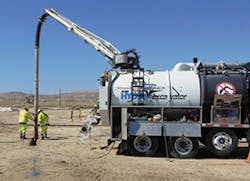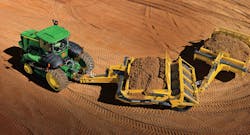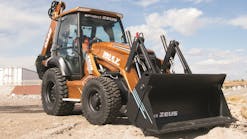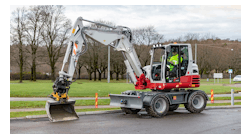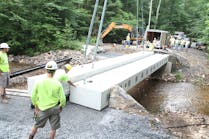After utilizing utility locators to determine a safe vacuum excavation site (see Part 1 on Utility Locators), author Carol Brzozowski explores the applications of air versus hydro excavation. Retaining and reusing dry soil at the excavation site are among the advantages of air excavation; however, “messy issues” such as dust control and site-based situations that do not permit the reuse of soil may necessitate other solutions. As Brzozowski further explains in the following segment, “Hitting the Hidden Mark,” contractors might wish to consider air/water combo units in such cases.
Hitting the Hidden Mark (Part 2) By Carol Brzozowski
The combination of the vacuum and utility locator help get that precise target.
The use of air versus water is the “great debate” on construction sites, says Jeff Wage, vice president of McLaughlin Group Inc.
“It’s the No. 1 question we hear,” he says. “Should we excavate with air? Should we go with water? The benefit of using air is if the soil is coming out of the ground, it can be reused and put back into the excavation dry.”
Air excavation is beneficial in that a contractor is not bringing in imported soils and hauling off the old, wet soil, he adds.
“The negative and the challenge is the productivity of air versus water: generally, hydro excavation is a more productive method for excavating than air,” Wage says. “There’s a good amount of mess that takes place when you’re using air. You can have more airborne material, more dust, and some other things that you’re trying to control when you’re using air versus water.”
From his perspective as a manufacturer, Wage says he sees usage as being 95% water or hydro excavation and 5% air.
“When we talk about that 5% use of air units, those are always combination air/water units, so if the contractor has an asset or a piece of equipment that they can’t dig with when they are on the job site due to job conditions, or if they’re not allowed to re-dump the soil back on the ground, they immediately go to water because they lost their benefit of reuse spoils. They’ll go to the more water and they always go with a combination air/water unit.”
Vermeer offers both air and hydraulic units by McLaughlin with spoil tank sizes ranging from 100 gallons to 3,000 gallons.
“You can do those in trailer units or skids, and once you get over 1,200 gallons you really need to go to skids and truck-mounted, because the trailers don’t want to carry anything larger than 1,200 gallons,” Wage points out.
Contractors wanting a combo unit need enough horsepower to run both the vacuum and air compressor simultaneously on the same power pack, Wage says.
“Once we get into the 99-horsepower category, that’s where we offer an air/water combo unit, so when we go to a 99-horsepower power pack, that’s where you can choose whether you want a 500-gallon all the way up to a 3,000-gallon,” he says. “You can get any of those in an air/water combo trailer or skid.”
The new Mega Vac line features 1,600-, 2,000-, 2,200-, 2,600-, and 3,000-gallon options with 1,025- and 1,200-cfm blower configurations with a new addition of a DEEP Blower option for HDD drill support, which creates 23 inches of mercury for handling heavy drill muds.
Another trend Wage notes is companies going to a boom when they’re doing a lot of potholing to minimize the labor involved in lifting and pulling the suction tool out of the ground.
“They do that with a hydraulic boom,” he says. “We’ve seen more and more booms, even on our smaller trailer units, 500-, 800-, and 1,200-gallon trailers, as well as our smaller truck-mounted units.
“If you’re potholing all day, running the water or air is not physically demanding, but when you’ve got all of that suction force and you’re lifting and pulling that suction tool up and down and in and out of the hole excavating the soils, that boom makes a big difference on that operator, just for the physical requirements and demands of the job.”
In the next part of this series—having explored air versus hydro excavation applications—Author Brzozowski discusses directional boring. Please click here to read Part 1 of this series.
